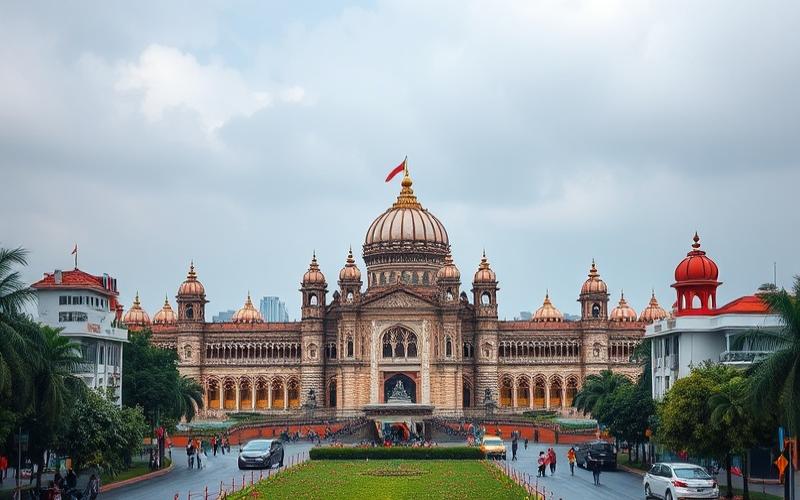
 Published on and written by Cyril Jarnias
Published on and written by Cyril Jarnias
As the world’s fifth-largest economy, India presents tremendous opportunities for international investors due to its rapid growth and dynamic demographics. With a growth outlook fueled by accelerated urbanization and an expanding middle class, the country is home to promising sectors ready to deliver attractive returns.
Information technology, where India has established itself as a global leader, continues to attract massive investments. Additionally, the manufacturing sector, supported by the “Make in India” initiative, and the renewable energy sector, driven by incentive policies, are emerging as potential pillars for lucrative investments.
These trends underscore why India remains a preferred destination for those seeking sustainable returns in an ever-changing global economic environment.
Analysis of Economic Opportunities in India
Most Promising Economic Sectors
- Information Technology: India is a global IT leader, with massive investments in artificial intelligence, cybersecurity, semiconductors, and private R&D. The government supports this sector through incentives and favorable policies.
- E-commerce: Rapid growth of the middle class, urbanization, and digitalization are driving strong expansion in online commerce.
- Renewable Energy: India is heavily investing in solar, wind, and other green energy sources, aiming to reduce its coal dependency and meet climate goals.
- Infrastructure: Record public spending on roads, railways, ports, and digital infrastructure, with strong support from government initiatives.
- Financial Services: Growth in banking access, fintech development, and increased openness to foreign investment.
| Sector | Key Opportunities | Initiatives and Policies |
|---|---|---|
| Information Technology | AI, cybersecurity, cloud, R&D, digitalization | Digital India, innovation support |
| E-commerce | Strong market growth, new consumers | Make in India, Digital India |
| Renewable Energy | Solar, wind, green hydrogen | Tax incentives, public-private partnerships |
| Infrastructure | Roads, ports, smart cities, logistics | Record public investments |
| Financial Services | Fintech, banking access, digital payments | Openness to foreign capital |
Recent Growth Data
- GDP estimated at $4 trillion USD in 2025; India is the fourth-largest global economy and aims for third place in the medium term.
- GDP growth projected at 6.5% in 2025 according to the IMF, following 8.2% in 2024.
- Continued rise in business creation, especially in major metropolitan areas and emerging states.
Government Policies and Major Initiatives
- Make in India: Promotes local manufacturing, job creation, and foreign direct investment across multiple sectors.
- Digital India: Accelerates digitalization of public services, digital inclusion, and development of digital infrastructure.
- Tax and regulatory incentives for foreign investments, simplified procedures, and special economic zones.
Demographic Trends and Consumption
- Expanding workforce: India benefits from a significant demographic dividend with a young and growing population.
- Rapidly growing middle class: Drives domestic demand, e-commerce sector, and consumption of modern goods and services.
- Urbanization and access to digital technologies strengthen consumption dynamics.
Challenges and Constraints
- Complex regulatory framework: Bureaucracy, regional variations, and regulatory uncertainties sometimes hinder investments.
- Inadequate infrastructure: Despite progress, gaps remain in transportation, logistics, and energy, which can limit economic efficiency.
- Market volatility: Rupee depreciation, high inflation, and foreign capital outflows can create risks for investors.
- Insufficient job creation: The labor market struggles to absorb the growing workforce, creating social and economic tensions.
Business Environment Improvement Measures
- Structural reforms to simplify taxation, improve data protection, and strengthen cybersecurity.
- Massive public investments in physical and digital infrastructure.
- Incentives for foreign companies and active promotion of foreign direct investment through single-window systems and accelerated procedures.
- Anti-corruption efforts and improved administrative transparency.
Key Takeaways
India combines economic dynamism, a young population, a growing middle class, and pro-business policies.
Opportunities are significant, especially in tech, energy, infrastructure, and services.
Challenges persist, but the government is implementing numerous reforms to attract investors and strengthen the country’s competitiveness.
India is establishing itself as an essential destination for investment and business development in Asia in the coming years.
Good to Know:
India offers a range of economic opportunities, particularly in information technology, e-commerce, and renewable energy, sectors boosted by GDP growth of around 6-7% in recent years. Government initiatives like Make in India and Digital India promote a favorable climate for foreign investment by simplifying regulatory frameworks and encouraging infrastructure development. Meanwhile, the expanding middle class stimulates consumption, fueling the financial services and e-commerce sectors. However, still inadequate infrastructure and market volatility can present challenges. Despite this, reforms aimed at strengthening the business environment, such as simplifying the tax regime and improving transportation networks, are underway to attract investors. The potential of the Indian market is supported by a young and dynamic population, representing a major asset for companies seeking to establish a lasting presence.
Promising Sectors for European Investors
Indian economic sectors particularly attractive to European investors:
| Sector | Assets for European Investors | Current and Future Trends |
|---|---|---|
| Information and Communication Technology (ICT) | Dynamic market, sustained growth, startup ecosystem, IT services expertise | 9.4% annual growth, $245 billion revenue in 2023, development of Europe-India collaborations, expansion of startups into Europe |
| Renewable Energy | Strong climate commitments, international financial support, wide range of technologies (wind, solar, biomass) | EU-India joint investments (renewable hydrogen, battery recycling), development of new projects (photovoltaic, biofuels), priority on environmental sustainability |
| Infrastructure | Massive need for urban and rural modernization, sustainable urban transport projects, EIB support | EU-India connectivity initiatives, involvement in Global Gateway, accelerated modernization of transport and logistics infrastructure |
| Pharmaceuticals and Biotechnology | Presence of robust supply chains, cooperation on active pharmaceutical ingredients, rapidly growing market | Strengthening value chains, increased openness to bilateral cooperation, support for innovation and local production |
Government Policies and Economic Reforms Favoring Foreign Investment:
- Simplification of foreign direct investment (FDI) procedures in many sectors.
- Specific tax incentives for investments in renewable energy, pharmaceutical manufacturing, and ICT.
- Programs promoting local manufacturing (Make in India), innovation (Startup India), and digitalization (Digital India).
- Strategic partnerships between the EU and India to strengthen value chain resilience, secure supplies, and facilitate technological cooperation.
- Joint agreements for financing green projects, research and development, and harmonizing technical standards.
Specific Incentives Offered to European Investors:
- Access to joint financing (e.g., €60 million for renewable hydrogen and battery recycling).
- Priority access to certain public procurement and pilot projects under EU-India initiatives.
- Facilitated connections with local partners (startups, industrial clusters).
- Workshops and cooperation platforms on standardization and technological innovation.
Potential Challenges for European Investors in India:
Points to consider:
- Infrastructure: Despite progress, some regions still suffer from logistical deficits, urban congestion, and lack of reliable transport or energy infrastructure.
- Regulation: Administrative complexity, sometimes fluctuating compliance requirements, diversity of legislation among Indian states.
- Intellectual Property: Protection sometimes deemed insufficient, particularly in technology and pharmaceutical sectors.
- Local Competition: Presence of powerful Indian players, need to adapt to a highly competitive and evolving market.
- Non-Tariff Barriers: Technical standards, customs procedures, and certification requirements that can slow market access.
Summary of Opportunities and Challenges:
India offers an expanding market with promising sectors for European investors, supported by reforms, financial incentives, and strong political will for bilateral cooperation.
Structural and regulatory challenges remain, but continuous efforts aim to improve the business environment and facilitate foreign investment.
Good to Know:
European investors can find lucrative opportunities in India in rapidly expanding sectors such as information and communication technology, renewable energy, infrastructure, and pharmaceutical and biotechnology manufacturing. The Indian government’s support for foreign direct investment, reinforced by favorable economic reforms and incentives like “Make in India” and “Digital India,” continues to attract European capital. However, challenges remain, including regulatory complexities and infrastructure shortcomings, which require a well-planned approach strategy. Examples like increased investments in solar parks or data centers illustrate the potential of these sectors. The investment climate is also improved by bilateral promotion and protection agreements, which safeguard European investors’ interests while opening new avenues for innovative collaborations.
Indian Economy Trends
Analysis of current and emerging trends in the Indian economy
The Indian economy is experiencing robust but slightly slowing growth, with a rate projected around 6.4% to 6.7% for 2025-2026, following an exceptional post-pandemic peak. Despite this relative slowdown, India remains the regional locomotive in Asia, ahead of China. The momentum is primarily supported by domestic consumption and local investments.
High-Growth Sectors
| Sector | Current Dynamics | Key Opportunities |
|---|---|---|
| Information Technology (IT) | Continued digital expansion and IT exports; rise of artificial intelligence | Persistent global demand for digital services; leadership in software development |
| Renewable Energy | Major investments in solar and wind; national incentive policies | Reduction in fossil fuel imports; creation of skilled jobs |
| E-commerce | Rapid growth due to mobile internet penetration; diversification into rural areas | New logistics platforms; fintech integration |
| Telecommunications | Accelerated 5G network deployment | Innovation in mobile uses (payment, connected health) |
| Real Estate & Construction | Expected recovery due to public infrastructure spending | Growing urbanization; residential market dynamism |
Recent Economic Reforms and Potential Impacts
- Tax simplification: Gradual implementation of a more transparent tax system (notably via GST), facilitating interstate trade.
- Targeted industrial policies: Increased support for local manufacturing (“Make in India”), particularly in electronics and electric vehicles.
- Agricultural sector reforms: Partial modernization aimed at better integration of agricultural logistics chains.
- Green energy incentives: Preferential tariffs, subsidies for solar/wind production.
Expected impact:
- Strengthening of certain strategic sectors (digital, clean energy)
- Improved business climate
- Gradual mitigation of some structural rigidities
Medium and Long-Term Economic Forecasts
Key forecast highlights:
- Annual growth expected between 6% and 7% until 2030 according to several cautious scenarios
- Gradual catch-up to pre-COVID levels with sustained surpassing anticipated from mid-2020s
Potential obstacles:
- Persistent fragility of the formal labor market facing high annual entrants
- Volatile food inflation weighing on households’ real purchasing power
- External vulnerability linked to geopolitical or climate shocks impacting energy or agricultural supplies
Major opportunities:
For institutional/foreign investors:
- Relatively high valuation but justified by solid structural prospects
- Underexploited potential in smart urban infrastructure (“smart cities”)
- Strong sustained domestic demand driven by young demographics
Recent Policy Changes Influencing These Trends
Non-exhaustive list:
- Emphasis on digital inclusion, massive training in digital/AI skills to meet growing need for qualified workforce
- Policies favoring foreign direct investment, selective sectoral regulatory easing
- Increased fiscal decentralization, allowing greater regional latitude to support innovation & localized industrial development
Urban & Industrialization Perspectives
The anticipated acceleration of urbanization, combined with a national “Smart Cities” strategy, opens a vast field for modern real estate investments as well as industrial expansion oriented toward domestic markets. The focus on energy transition also favors decarbonized industrial development.
⚡ Prospects remain generally positive despite some temporary headwinds. Technological innovation, combined with rapid urbanization supported by a dynamic private sector and structural pro-investor reforms, should continue to fuel a virtuous cycle.
Good to Know:
The Indian economy is currently experiencing dynamic growth thanks to sectors like information technology, renewable energy, and e-commerce, which benefit from increased investments and favorable policies. Economic reforms, such as initiatives to improve manufacturing and digital industries, have strengthened the business climate, attracting new investments. With rapid urbanization and efforts to reduce energy dependency, India is diversifying its resources toward sustainable solutions, thus stimulating industrialization. However, despite encouraging economic forecasts, India must overcome challenges such as regional disparities and political instability that can influence investment prospects. Recent tax relaxations and accelerations in digitalizing administrative processes demonstrate the country’s commitment to simplifying business, offering considerable opportunities for investors seeking to leverage India’s growth potential.
Disclaimer: The information provided on this website is for informational purposes only and does not constitute financial, legal, or professional advice. We encourage you to consult qualified experts before making any investment, real estate, or expatriation decisions. Although we strive to maintain up-to-date and accurate information, we do not guarantee the completeness, accuracy, or timeliness of the proposed content. As investment and expatriation involve risks, we disclaim any liability for potential losses or damages arising from the use of this site. Your use of this site confirms your acceptance of these terms and your understanding of the associated risks.




















































